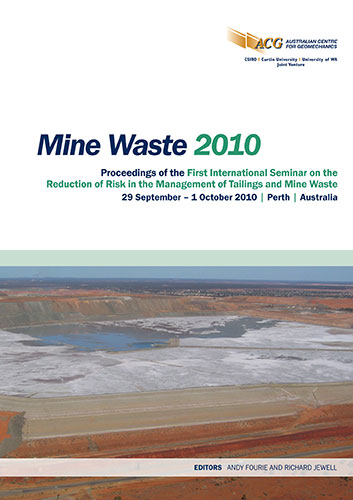Risk assessment of mine tailings/waste surface ponds

|
Authors: Pytel, W |
DOI https://doi.org/10.36487/ACG_rep/1008_20_Pytel
Cite As:
Pytel, W 2010, 'Risk assessment of mine tailings/waste surface ponds', in R Jewell & AB Fourie (eds), Mine Waste 2010: Proceedings of the First International Seminar on the Reduction of Risk in the Management of Tailings and Mine Waste, Australian Centre for Geomechanics, Perth, pp. 229-242, https://doi.org/10.36487/ACG_rep/1008_20_Pytel
Abstract:
A general approach for risk assessment of surface tailings/waste storage facilities is presented using Event Trees based on typical failure modes. The relevant modes of failure involve either movement of large volumes of material, often in three-dimensions leading to dam breakage and uncontrolled release of the facility content, or to contamination of the environment with no structural failure. This paper focuses on the fact that natural materials are spatially variable and that a proper stochastic representation of this variability is crucial to achieving a realistic understanding of the geotechnical and hydro-geological safety issues. The risk model consists of products and sums of different risks described by their corresponding probabilities and associated consequences, some of which may be mutually correlated.
References:
Agterberg, P.G. (1974) Geomathematics, Elsevier Scientific Publishing Co., Amsterdam-London-New York.
Australian Geomechanics Society (AGS) (2000) Landslide Risk Management Concepts and Guidelines, AGS
Subcommittee on Landslide Risk Management, Australian Geomechanics, Vol. 35 (1).
Australian National Committee on Large Dams (ANCOLD) (1999) Guidelines on Tailings Dam Design, Construction
and Operation.
Australian National Committee on Large Dams (ANCOLD) (2003) Guidelines on Risk Assessment, October 2003.
Baecher, G.B. (1987) Geotechnical risk analysis user’s guide, FHWA / RD-87-011, Federal Highway Adm. McLean.
Benjamin, J.R. and Cornell, C.A. (1970) Probability, statistics, and decision for civil engineers, McGraw-Hill, Inc.
Fenton, G.A. and Griffiths, D.V. (2008) Risk Assessment in Geotechnical Engineering, John Wiley & Sons Inc., New
York.
Griffiths, D.V. and Fenton, G.A. (2004) Probabilistic slope stability analysis by finite elements, ASCE Journal of
Geotechnical and Geoenvironmental Engineering, Vol. 130, No. 5, pp. 507–518.
Grosh, D.L. (1989) A primer of reliability theory, John Wiley & Sons Inc., New York.
HMSO Health and Safety Executive (1978) Canvey: Summary of an Investigation of Potential Hazards from Operations
in the Canvey Island/Thurock Area, London.
ICOLD (1989) Tailings Dams Safety, Guidelines, Commission Internationale des Grands Barrages, Paris, Bulletin 74.
ICOLD (1996) A Guide to Tailings Dams and Impoundments – Design, Construction, Use and Rehabilitation,
Commission Internationale des Grands Barrages, Paris, Bulletin 106.
Jaskiewicz, K. (1999) Weryfikacja zależności empirycznych rozprzestrzeniania się drgań w obszarach górniczych ZG
Lubin, ZG Polkowice – Sieroszowice i ZG Rudna oraz opracowanie metodologii określania parametrów drgań
dla wstrząsów górniczych o wysokich energiach, Res. Rep. for KGHM S.A., CBPM Cuprum, Wrocław.
Legislation, Authorization, Management, Monitoring and Inspection Practices (LAMMIP) (2005) Kreft-Burman K.,
Saarela J., Anderson R., TAILSAFE, SYKE, Helsinki, Finland.
Moss, R.E.S., Seed, R.B., Kayen, R.E., Stewart, J.P. and Der Kiureghian, A. (2006) CPT-based probabilistic assessment
of seismic soil liquefaction initiation, PEER 2005/15.
Rackwitz, R. (2000) Reviewing probabilistic soil modelling, Computer and Geotechnics, No. 26, pp. 199–223.
Rethati, L. (1988) Probabilistic Solutions in Geotechnics, Elsevier.
Rico, M., Benito, G., Salgueiro, A.R., Dfez-Herrero, A. and Pereira, H.G. (2008) Reported tailings dam failures,
A review of the European incidents in the worldwide context, Journal of Hazardous Materials, Vol. 152,
pp. 846–852.
SveMin (2007) GruvRIDAS – Gruvindustrins riktlinjer för dammsäkerhet (the Mining Industry Guidelines for Dam
Safety), in Swedish.
TAILSAFE (2004) Sustainable Improvement in Safety of Tailing Facilities, A European Research and Technological
Development Project, Contract No. EVG1-CT-2002-00066, K.J. Witt and M. Schonhardt (eds).
Thao, N.T.P. (1984) Statistics of geotechnical parameters of selected soil deposits from the Wroclaw area (in Polish),
Res. Rep. of Geotechnical Institute, Wroclaw University of Technology, No. 14, pp. 85–95.
U.S. Committee on Large Dams (USCOLD) (1994) Tailings Dam Incidents, Denver, Colorado, 82 p.
UNEP/ICOLD (2001) Tailings Dams - Risk of Dangerous Occurrences, Lessons learnt from practical experiences,
Bulletin 121, Published by United Nations Environmental Programme (UNEP) Division of Technology, Industry
and Economics (DTIE) and International Commission on Large Dams (ICOLD), Paris, 144 p.
United Nations Environment Programme (UNEP) (1996) Environmental and Safety Incidents concerning Tailings
Dams at Mines: Results of a Survey for the years 1980-1996 by Mining Journal Research Services; a report
prepared for United Nations Environment Programme, Industry and Environment, Paris, 129 p.
© Copyright 2026, Australian Centre for Geomechanics (ACG), The University of Western Australia. All rights reserved.
View copyright/legal information
Please direct any queries or error reports to repository-acg@uwa.edu.au
View copyright/legal information
Please direct any queries or error reports to repository-acg@uwa.edu.au